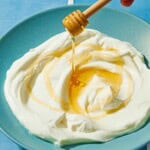Greek Yogurt
With this simple recipe you can make your own Greek yogurt with only 2 ingredients and no special equipment! It's easy to make, more flavorful than any commercial yogurt, and more economical as well!
Servings: 6.5 cups
Equipment
Ingredients
- 1/2 gallon milk, whole or 2% (8 cups)
- 1/4 cup plain yogurt with live active cultures, at room temperature
Instructions
- Heat the milk. Rinse the inside of a heavy 3- to 4-quart pot with a lid with cold water. This will help to prevent the milk from scorching as it cooks. Add milk to the pot and place it over medium heat, stirring every now and then so it does not scorch on the bottom. Bring milk to a gentle simmer; this will take about 15 minutes. When you see bubbles forming around the edges of the pot, check its temperature using an instant read thermometer. Once the milk is between 190°F and 200°F, remove the pot from the heat.
- Cool the milk. Allow the milk to cool in the pot, stirring every now and then, as it cools down to between 105°F and 115°F. If the temperature drops too much, gently reheat the milk again.
- Incorporate the starter yogurt. Add the yogurt to a small heat-proof bowl. Slowly stir 1/2 cup of the warm milk into the yogurt to temper and thin it out. Slowly stir the yogurt-milk mixture gently into the pot to distribute the yogurt culture.
- Incubate the mixture. Cover the pot with a lid and place it in a warm place to rest, undisturbed, for at least 6 hours and up to 10 hours until the yogurt sets. Options include wrapping the pot in a thick towel and leaving it on your counter to keep it warm, or turning your oven on the lowest setting, then shut it off and store the pot in the warmed oven. The time it takes to set will depend on the temperature of the environment at which it is being held. When ready, the yogurt will appear somewhat set, no longer liquid.
- Chill the yogurt. Place the whole pot in the refrigerator, without disturbing it, and chill for a minimum of 6 hours and up to 2 days. During this time, it will continue to thicken and develop a nice tangy flavor.
- Strain the yogurt. Set a fine-mesh strainer or colander over a large bowl and line it with finely-woven cheesecloth. Spoon the yogurt into the strainer and return it to the refrigerator. Allow the whey to drain into the bowl until the yogurt gets as thick as you like it, 2 to 8 hours.
- Store and enjoy. Transfer the yogurt to airtight containers and store it in the refrigerator for up to 2 weeks.
Notes
- Visit our shop to browse quality Mediterranean ingredients including olive oils, honey, jams, and spices.
- These storage jars are great for storing the yogurt and even have room to stir in extras. They are the same jars used in the photos.
- Why heat the milk? Heating the milk to between 190°F and 200°F ensures that any bad bacteria are eliminated before culturing it with starter yogurt. It also breaks down the milk proteins, which can also contribute to a yogurt with a pleasant, thick texture. This step isn’t crucial if you’re starting with pasteurized milk.
- When cooling the milk: You can speed up this cooling process by placing the whole pot in an ice bath. When the temperature of the milk has dropped to 112°F, remove it from the ice bath.
- To incubate the yogurt: The ideal incubation temperature range for yogurt is between 108°F and 112°F. You can wrap the whole pot with a large, clean towel to help keep it warm. To create a warmer environment than the kitchen counter, you can use a bread proofing setting on your oven, if it has one. Alternatively, put your oven on its lowest temperature setting (typically between 170°F and 200°F) for a few minutes and immediately turn it off, then place the warm pot in the oven.
- To make regular yogurt: You can also skip the step of straining and just use this recipe to make regular yogurt. After culturing the milk simply transfer it to the refrigerator. This recipe will yield about 8 cups regular (unstrained) yogurt. The whey will naturally separate as the yogurt sits in the refrigerator. Feel free to pour it away or stir it back into the yogurt, whatever you prefer.
- To use homemade yogurt as a starter: If you plan to make yogurt again, save some of your yogurt to use as the starter for your next batch. Simply measure 1/4 cup of yogurt and place in an airtight container in the refrigerator. Use it within a week or so to make sure the culture is still strong and active.
Nutrition
Calories: 180.5kcal | Carbohydrates: 14g | Protein: 9.9g | Fat: 9.6g | Saturated Fat: 5.6g | Polyunsaturated Fat: 0.3g | Monounsaturated Fat: 2.1g | Cholesterol: 36.2mg | Sodium: 115mg | Potassium: 451.4mg | Sugar: 14.4g | Vitamin A: 481IU | Vitamin C: 0.05mg | Calcium: 369.6mg | Iron: 0.005mg
QR code
Scan this QR code with your phone's camera to view this recipe on your mobile device.
